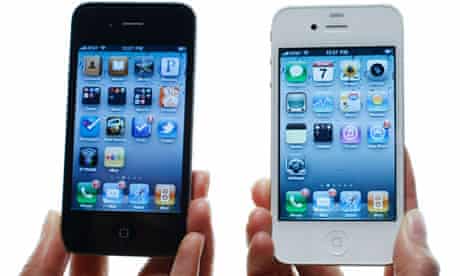Second one. This is a biggie. Something we call the retina display. What's that?
第二项。这可是个重头。我们称之为“视网膜屏幕”的一个东西。是什么呢?
Well, in any display there are pixels. Here's four of them.
在任何显示器上都存在像素。这里有四个。
We start off with the retina display by dramatically increasing the pixel density.
我们从“视网膜屏幕”开始,大幅增加了像素密度。
Four times as many pixels in the same amount of space.
在相同的空间中,像素是原来的四倍。
Now why is that important? Well, let's make more pixels.
为什么这很重要?好吧,让我们演示一下更多的像素。
And let's say we want to draw the letter A.
假设我们要显示字母A。
And this is the outside boundary of one of the strokes of the letter, the letter A.
而这是字母A的一个笔划的外边界。
While you can see we turn on pixels inside that stroke, we can get far more precision the more pixels we have.
你们可以看到,我们点亮了笔划内的像素,我们可以得到更高的精度,如果有更多的像素的话。
And we play all sorts of tricks by putting different levels of grey pixels on that line as well to try to fuzz it for our eye.
同时我们运用了各种各样的小技巧,把不同级别的灰色像素放在那一笔划上,试图让人眼难以分辨。
But when we zoom out of this, what you can see is that because we have four times as many pixels,
但当我们缩小,你会看到,因为我们有四倍的像素,
we get really really sharp text compared to what we normally get on displays of lesser resolution.
与通常分辨率较低的显示器相比,我们得到的文本会非常清晰。
Now the retina display has 326 pixels per inch.
现在的视网膜屏幕,每英寸有326个像素。
There's never been a display like this on a phone.
这种屏幕是手机上从来没有过的。
People haven't even dreamed about a display like this on a phone. But it's more than that.
人们甚至做梦都没想到手机会有这样的屏幕。但还不止这些。
It turns out that there's a magic number right around 300 pixels per inch,
研究发现,有那么一个神奇的数字,大约每英寸300像素,
that when you hold something around 10 or 12 inches away from your eyes, is the limit of the human retina to differentiate the pixels.
当你拿着这个东西,离眼睛10或12英寸远的时候,这就是人类视网膜区分像素的极限了。

And so they're so close together when you get at this 300 pixels per inch threshold
所以当你达到每英寸300像素的阈值时,
that all of a sudden things start to look like continuous -- continuous curves like,
突然间它们开始变成像是一条连续的曲线,
text looks like you've seen it in a fine printed book, unlike you've ever seen on an electronic display before.
那些文字看起来就像你是在一本印刷精良的图书上的着到的一样,与你以前在电子显示屏上看到的效果完全不同。
And at 326 pixels per inch we are comfortably over that limit and it's extraordinary.
通过在每英寸上设置326像素,我们平滑地越过了这一限制,这是非常了不起的。
So let me give you an example of a normal display on the left and the retina display on the right.
我给你们举个例子,左边是正常屏幕,右边是视网膜屏幕。
Look at the difference. Can you see it?
看看区别。能看得出来吗?
Here are some more texts of different sizes and different weights and you can really really see this stuff.
这里有一些不同尺寸和粗细的文字,你可以真切地看到区别。
Once you use a retina display, you can't go back.
一旦你使用了视网膜屏幕,你就回不去了。
When you get the character based languages, Kanji in this case, it's also striking.
当涉及到以单字符为单位的语言时,比如说日文汉字,效果依然无敌。
And it's not just texts, it's images and video as well.
不仅仅是文字,还有图像和视频。
Look at the difference. This is the same image on a normal display and a retina display.
看看区别。这是正常屏幕和视网膜屏幕上的同一张图像。
Here's another one. Pretty amazing, isn't it?
这是另一张。太神奇了,不是吗?
So what I'd like to do now is show this to you live.
我现在要做的是现场展示给你们看。
I've got an iPhone 3GS which has got a widely praised display on it and I've got a new iPhone 4.
我有一部iPhone 3GS,它的屏幕广受好评,我还有一部新的iPhone4。
So let me get them both fired up here. There we go.
让我把他们俩都炒了。就这样。
And I can ask them to blow these up, there we go. Look at that difference now.
我把它们俩都开启,好了。现在看看区别。
This is pixel -- we had to get special projectors for this because most projectors can't display as many dots as are on a retina display.
这是像素--我们必须用特殊的投影仪,因为大多数投影仪不能像视网膜屏幕那样显示那么多的点。
So this is pixel for pixel accurate right off these two displays and you can really see it.
这就是像素对像素的精确显示,你们可以看到。
Look at that folder there and then let me go inside and you can look at the icon of the folder, compare them.
看看那个文件夹,然后我点进去,可以看看文件夹的图标,比较一下。
Look at the texts, look at the linen, look at the icon of the compass, the icon of the clock, isn't that amazing?
看看文字,看看桌面背景,看看指南针的图标、时钟的图标,是不是很神奇?



